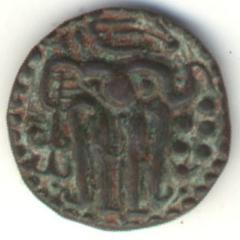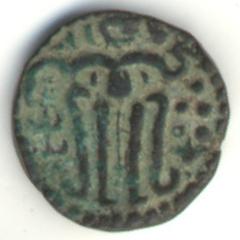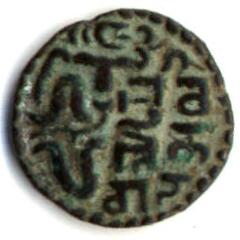| SPECIFICATIONS | |
| Denomination | massa |
| Alloy | Copper |
| Type | Struck |
| Diameter | 19.00 mm |
| Thickness | mm |
| Weight | 4.13 gms |
| Shape | Round |
| Edge | Plain |
| DieAxis | O° |




|

| 
| ||||||||||||||||||||
| Codrington #86 | Mitchiner #850 | |||||||||||||||||||||
| There are many variations of these massa coins, particularly those of BhuvanaikaBahu. The script of legend and other features on type illustrated on right is significantly different from that above. | 
| 
| ||||||||||||||||||||
| Codrington #87 | Mitchiner #851-852 | |||||||||||||||||||||
|
Obverse : Traditional Lankan mass-a design of standing king. The head consists of an irregular oblong, the right side being a vertical line, from which projects three horizontal stokes representing the nose, mouth and chin. The crown bulging outwards at the back. The two curved lines on either side of the legs slightly turned upwards at the end indicate a person wearing a dhoti, and standing on a lotus stalk with flower to the right. The forearm is bent sharply down; the hand grasps the hanging lamp. The right side elbow is curved down with the arm turned upwards holds a flower presumed to be a jasmine blossom. To the right are five dots or spheres. A rim of 40 to 43 beads. Reverse : Traditional Lankan massa design of seated king. Head and crown as on obverse. Arm is raised upwards and the hand holds a conch shell. On right Nagari legend Sri Bhu va nai ka Ba hu | 
|
This is one of six fairly common copper massa coins from the late Polonnaruwa and Dambadeniya era.
I quote from Codrington's "Short history of Ceylon"
since the ancient chronicle Culavamsa becomes too verbose
in this period.
Vijayabahu IV's younger brother, BhuvanaikaBahu succeeded in escaping;
the usurper general Mitta failing to secure allegiance of the south
Indian mercenaries, who had been won over by the true heir, was
murdered, and the BhuvanaikaBahu (1273-1284) crowned and reigned
eleven years. Early in his reign he had to deal with a Pandyan
invasion, which he repelled ; thereafter he lived for a few years at
Dambadeniya, and then removed to Yapahu.
Text edited from
* Ceylon Coins and Currency: H. W. Codrington, Colombo, 1924.
Chapter VI Mediaeval Lanka - Sinhala of 12th & 13th Century - Series II, Page 70
* Culavamsa II Chapter LXXXI: Translation by Wilhelm Geiger. Pali Text Society 1930
The coin was scanned at 300dpi and displayed at 300dpi is from my original collection from Lanka.